Historical Walking Tour
 Download a copy of the Historic Walking Tour Brochure
Download a copy of the Historic Walking Tour Brochure
1. Greenway High School
2. Coleraine Village Hall
3. Company Housing District
4. The Kean Home
5. The General Mining Superintendent’s Home
7. Coleraine Carnegie Library
8. Longyear Park
9. The Methodist Episcopal Church
10. The Log Church
11. The Vandyke Home
12. The Sears, Roebuck and Co. Home
13. The Claypool Log Home
14. Coleraine Ski Jump Site
 1. Greenway High School, 308 Roosevelt Street. The high school was built to accommodate a fast-growing population and was named for mining company superintendent and town founder, John C. Greenway. An existing building called the Greenway School, constructed in 1908 for all 13 grade levels, had quickly become overcrowded and cloakrooms had to be used as additional classrooms for some of the 200 students. Greenway High School was completed in 1922 and boasted 310 rooms, a 20-by-60-foot swimming pool and an auditorium with seating for 1,000. At one time, it housed offices for a doctor and dentist to provide student care. The school was described as “a good example of the extravagant use of the iron ore tax money in the small towns on the Mesabi Range.” In having a new school in Coleraine, the school superintendent saw the opportunity to provide students with access to higher education. With help of area businessmen, a junior college was established in 1922. It was located on the third floor of the high school until the move in 1967 to its current location in nearby Grand Rapids. Today, Greenway High School accommodates approximately 325 students in grades 9-12.
1. Greenway High School, 308 Roosevelt Street. The high school was built to accommodate a fast-growing population and was named for mining company superintendent and town founder, John C. Greenway. An existing building called the Greenway School, constructed in 1908 for all 13 grade levels, had quickly become overcrowded and cloakrooms had to be used as additional classrooms for some of the 200 students. Greenway High School was completed in 1922 and boasted 310 rooms, a 20-by-60-foot swimming pool and an auditorium with seating for 1,000. At one time, it housed offices for a doctor and dentist to provide student care. The school was described as “a good example of the extravagant use of the iron ore tax money in the small towns on the Mesabi Range.” In having a new school in Coleraine, the school superintendent saw the opportunity to provide students with access to higher education. With help of area businessmen, a junior college was established in 1922. It was located on the third floor of the high school until the move in 1967 to its current location in nearby Grand Rapids. Today, Greenway High School accommodates approximately 325 students in grades 9-12.
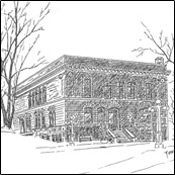 2. Coleraine Village Hall, 302 Roosevelt Street. In 1909, the village of Coleraine received a charter to operate as established by the State of Minnesota. The first governing body consisted of village mayor Mike Curley (superintendent of the Canisteo Mine), three councilmen and a clerk.The council was chiefly responsible for constructing streets, sidewalks and a firehall, as well as providing police protection, health services and garbage collection, to name a few.
2. Coleraine Village Hall, 302 Roosevelt Street. In 1909, the village of Coleraine received a charter to operate as established by the State of Minnesota. The first governing body consisted of village mayor Mike Curley (superintendent of the Canisteo Mine), three councilmen and a clerk.The council was chiefly responsible for constructing streets, sidewalks and a firehall, as well as providing police protection, health services and garbage collection, to name a few.
On July 21, 1909, the council received a petition signed by 29 residents asking it to construct a village hall that would contain suitable quarters for the fire department, council chambers and a fireproof jail, plus an auditorium on the second floor for public gatherings. The village attorney was instructed to draw up a resolution relative to holding a special election to vote on a bond sale, with the proceeds being used to secure a site for the new village hall. That site turned out to be Lots 10, 11 & 12 of Block 6 on Roosevelt Avenue (now Roosevelt Street), which were purchased in February 1910 for $2,500 from the Hope Mining Company.
On March 4, the council accepted the $29,565 bid of Emil Johnson of Duluth, Minnesota, to build the village hall. A dedication ceremony was held in May, and placed inside the cornerstone was a sealed box containing records about the structure, copies of local and regional newspapers, and the name of every resident of Coleraine.
The village hall has served the community long and well. The council chambers, clerk’s office and vaults remain the same. The top floor, no longer used, was once the center for such village activities as plays, Saturday night movies, dances, traveling shows and Golden Gloves boxing.
The original jail has been removed and converted to police headquarters and two meeting rooms. A fire hall near Trout Lake serves the residents and its previous village hall location is now a community center named in honor of former mayor Vincent Nyberg.
The Coleraine Village Hall was named to the National Register of Historic Places in 1992.
3. Company Housing District, the 100 Block of Roosevelt Street. These six homes were the last real estate investment by the Oliver Iron Mining Company, a division of U.S. Steel (now USX) in the village of Coleraine. Their design typifies most company homes in Coleraine as well as other U.S.S. houses across the Mesabi Iron Range.
They were built in 1921 and leased to company management personnel. Alternating homes on the block were built using the same floor plan. The contractor was Johnson Brothers of Duluth.
In 1951, all of the homes were sold to their tenants. Floor plan changes and additions have been made since the homes were originally constructed.
4. The Kean Home, 201 Cole Street. Coleraine’s first physician, N. Dudley Kean, and his wife, Jennie, purchased two lots in 1907 for building their new home.
Kean had been hired as the Oliver Iron Mining Company surgeon and was extensively involved in the planning of a new hospital for the village.
The Keans lived in the residence until 1929, when the Cleveland-Cliffs Iron Mining Company purchased it for W.A. Sterling, superintendent of the Canisteo Mine. Over the years it served as home to several mining superintendents, and has been occupied by private owners since 1981.
Special features include a breakfast room, brick fireplace, sun porches on both first and second floors, and a fifth bedroom on the third floor.
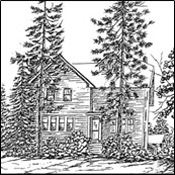 5. The General Mining Superintendent’s Home, 100 Cole Street. This home was built as the district general superintendent’s residence by the Oliver Iron Mining Company in 1910- 11, replacing an earlier log structure which was located north of downtown near what is now the NRRI Coleraine Minerals Lab.
5. The General Mining Superintendent’s Home, 100 Cole Street. This home was built as the district general superintendent’s residence by the Oliver Iron Mining Company in 1910- 11, replacing an earlier log structure which was located north of downtown near what is now the NRRI Coleraine Minerals Lab.
It was named to the National Register of Historic Places in 1982.
At the time of its construction, Michael Godfrey was district superintendent, having replaced John C. Greenway. Godfrey, his wife and two children were the home’s first residents.
It was thought to be quite lavish, located on a knoll east of the mining company office and overlooking Trout Lake, with much of the The General Mining Superintendent’s Home villages of Bovey and Coleraine in plain view. The landscaped grounds were a showplace, with manicured lawns and several flower beds. It was the site of many large social gatherings over the first half of the century.
The house is a two-and-a-half story frame structure covered by a multi-gabled roof. Originally the building was sheathed in clapboard and two-tone brown in color.
The interior remains virtually intact, having been carefully maintained by the mining company. A fully plastered and finished basement provides for four full floors of living space. The original detached frame garage is located on the property.
A stone stairway follows the hillside down to a grassy lakeshore area and sandy beach, where an original rock retaining wall and concrete and- steel boathouse still remain.
The home has had only five owners. In 1985, the southern section of the property was divided and a new home built on that site.
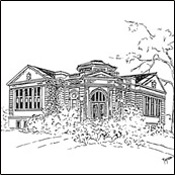 7. Coleraine Carnegie Library, 203 Cole Street. John C. Greenway reserved two village lots for a library and in 1909 began negotiations for a $15,000 gift from Andrew Carnegie.
7. Coleraine Carnegie Library, 203 Cole Street. John C. Greenway reserved two village lots for a library and in 1909 began negotiations for a $15,000 gift from Andrew Carnegie.
Four hundred volumes of books purchased in 1909 for $315 would form the nucleus for the new library, which was completed in 1910 at a cost of $17,537.
The doors opened January 2, 1911, with Mrs. W. C. (Jennie) Bollinger as librarian. Three years later, the library began serving rural schools by boxing up 25-40 books and sending them on buses to and from the buildings for use by students and teachers.
Meeting rooms, a fireplace and furnishings were added to the basement in 1923, and the renovated kitchen became a fully equipped facility that could serve 60 people.
From 1953 to 1967, the library was responsible for service to cities in Itasca County without library facilities, and again boxes of books were carried to each station, this time once a month. It has since joined a regional library courier system.
The building was placed on the National Register of Historic Places in 1980.
In an article in the September-October 1989 issue of Architecture Minnesota magazine, Coleraine Carnegie Library Simon Pepper, a senior lecturer in architecture at the University of Liverpool in England, described the Coleraine library as “one of the best preserved Minnesota Carnegie libraries.” Pepper had visited Coleraine during research on the architectural and social history of the American Public Library.
The library is home to the extensive Inga Nyman Photo Collection as well as other donated photos of early Coleraine. Also on permanent display is a quilt of Coleraine landmarks made by volunteers and presented to the city during its Diamond Jubilee celebration in 1984.
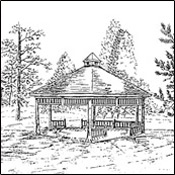 8. Longyear Park, along Cole Street. Designed and developed in 1914 by Conrad B. Wolf, the site was originally a cedar swamp full of cattails and bulrushes which first served as the location of an experimental washing plant in the early 1900s.
8. Longyear Park, along Cole Street. Designed and developed in 1914 by Conrad B. Wolf, the site was originally a cedar swamp full of cattails and bulrushes which first served as the location of an experimental washing plant in the early 1900s.
Named after E.J. Longyear, a mining pioneer in test drilling, the park included a labyrinth of walking paths, a fish pond, flower gardens and a gazebo built for band concerts along the lakeshore.
On the hill above the park, the painted American flag was a 1920s project of local elementary students who were each asked to bring a rock to school to help form the design. Carved out of the hillside were paved “baby walks” to permit the easy maneuvering of baby carriages down into the park.
The Coleraine City Band, organized in 1907, still performs weekly during the summer. Concerts take place at the log gazebo built in 1991 on the site of the park’s 1950s-era bandshell. With its scenic setting and amphitheater-style seating, the gazebo is also a popular location for weddings and community activities.
Near the center of Longyear Park, a plaque commemorates the beneficiation (processing to raise overall quality and strength) tests done on iron ore at one of Greenway’s first washing plants located near the Claypool log home on Lakeview Boulevard.
A favorite walking spot of Coleraine residents for more than 70 years has been the mile-long peninsula path, which begins at the east end of the park and encircles the bay below Lakeview Boulevard.
Improvements to Longyear Park have included a paved extension of the peninsula path to connect Longyear Park to Cotton Park on the north end of the lake, added in 1988; a Minnesota Department of Natural Resources fishing pier constructed in 1991; and a new boat launch in the park bay, added in 2008.
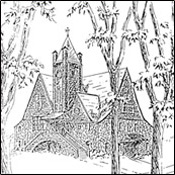 9. The Methodist Episcopal Church, 501 Cole Street. When the Methodist Episcopal Church was named to the National Register of Historic Places in 1982, it was described by the state’s historic preservation sites surveyor as easily the largest and most impressive religious edifice on the Western Mesabi Iron Range.”
9. The Methodist Episcopal Church, 501 Cole Street. When the Methodist Episcopal Church was named to the National Register of Historic Places in 1982, it was described by the state’s historic preservation sites surveyor as easily the largest and most impressive religious edifice on the Western Mesabi Iron Range.”
The shingle-styled structure was erected in 1908- 09 as a combination church and Young Men’s Christian Association (YMCA), which included a gymnasium, shower facilities, office, reading room and parlor. The town fathers felt the young people of the community should have an alternative to visiting the liquor establishments in nearby Bovey during their leisure time.
The foundation and walls of the superstructure were constructed of coursed fieldstone, gathered within a two-block radius of the building. Window openings of varying shapes and sizes pierce the stone walls. Most notable are the series of rectangular stained glass windows in the sanctuary, situated beneath the larger north/south gables. Large circular stained glass windows emphasize the shingled gables of the sanctuary.
Frank Young, a well-known and respected architect from Duluth, designed the building using the “Akron” plan, which utilizes increased seating capacity and consists of a sanctuary separated from adjoining rooms by removable partitions. In this case, partitions separate the sanctuary on the west half of the main floor from the three classrooms built beneath the choir loft on the east side. A pastor’s study is also in the east half.
The building is significant both as a major architectural expression of the single style in northern Minnesota and as a vital element of the planned community in Coleraine. Its cornerstone, laid in 1908, contains a capsule of artifacts collected from that period.
The church has had private owners since 1974.
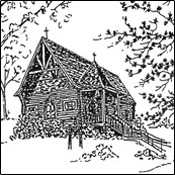 10. The Log Church, 601 Cole Street. The Episcopal Church of the Good Shepherd was built in 1908, the first church to be completed in Coleraine. John C. Greenway was a member of this parish and it was he who supervised the construction of the church.
10. The Log Church, 601 Cole Street. The Episcopal Church of the Good Shepherd was built in 1908, the first church to be completed in Coleraine. John C. Greenway was a member of this parish and it was he who supervised the construction of the church.
It was placed on the National Register of Historic Places in 1980.
It resembles in construction and style the then superintendent’s quarters of the Oliver Iron Mining Company first occupied by Greenway. This log structure, in the Oliver’s general shop area north of downtown, was also a Coleraine landmark but was torn down by the mining company in the early 1950s.
The logs used in the construction of the church were taken from one of the few remaining patches of virgin timber in the area. The interior of the church is built entirely of wood, including the cathedral ceiling. The altar rail and lectern are made of birch logs, still in their natural state. The large stained glass window at the rear of the church was donated by Greenway as a memorial to his young nephew, Addison White Greenway, who drowned in a hunting accident.
The church was dedicated by Bishop J.D. Morrison of the diocese of Duluth on November 15, 1908.
Because of declining enrollment, the last regular church service was held December 26, 1982. In March 1987, Christ Episcopal Church in Grand Rapids deeded the church and its property to the city of Coleraine with certain stipulations.
One was that the city maintain the basic architecture and appearance of the church so that it would continue to qualify for placement on the register of historic sites with the State of Minnesota.
A preservation plan was initiated by the city in 1989 with the replacement of church’s roof, front porch and railings, while volunteers restained the log exterior.
Since then, with oversight by the Log Church Preservation Committee and support from the Minnesota Historical Society, the Blandin Foundation, and private donations, projects have included exterior log restoration in 2000; accessibility ramp and French drain installation, 2002; new retaining wall and landscaping, 2003; and total window restoration, completed in 2004.
In 1990, the Log Church was given honorable mention in Midwest Living magazine’s Hometown Pride Awards contest for historic preservation projects, and in April 2001, the Duluth News Tribune highlighted the committee’s restoration and fundraising efforts in a feature story published in its Northland Communities section.
The church is available for weddings, special services and cultural events, with proceeds dedicated to continued preservation. More information on renting this space >>
11. The Vandyke Home, 607 Cole Street. The site for this home was selected by J.A. Vandyke, who came to Coleraine in 1906 as the first superintendent of schools, overseeing the building of a new school and earning an annual salary of $2,000.
His home was built on a main village thoroughfare and was ready for his family of six in August 1907.
The house boasted seven bedrooms, with three on the top floor often rented to teachers or used by guests. The west side entry design allowed direct access to the basement, kitchen or upper floors without disturbing other family members. The home was often the scene of committee meetings and social events, since the Vandykes were active in church and other community organizations. Vandyke’s eldest daughter was married in the living room of the home in 1912.
Throughout the years, residents of Coleraine referred to the location as Vandyke’s corner, and it was a popular rendezvous spot for children in town.
In 2008, recordings of J.A. Vandyke describing life in early Coleraine were discovered and are now part of the Itasca County Historical Society collection.
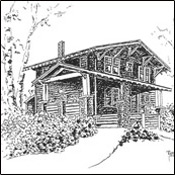 12. The Sears, Roebuck and Co. Home, 301 Lakeview Boulevard. Between 1909 and 1937, Sears, Roebuck and Co. sold approximately 100,000 mail-order “Honor Built” homes. Unexceptional pieces of architecture, they copied popular styles of the day.
12. The Sears, Roebuck and Co. Home, 301 Lakeview Boulevard. Between 1909 and 1937, Sears, Roebuck and Co. sold approximately 100,000 mail-order “Honor Built” homes. Unexceptional pieces of architecture, they copied popular styles of the day.
Instructions were bound in leather and bore the new homeowner’s name in gold motif. Architectural creativity was discouraged: “Do not take anyone’s advice as to how your building should be erected,” the manual stated, “as this causes more difficulty than all other things put together.” It also called for extra care in the construction of the porch, since “this part of your home is seen first and last.”
Many of these homes still stand and are in sound condition, and several have been featured in publications of the National Trust for Historic Preservation, an organization for the preservation of sites significant in American history. This particular chalet-style home was built in 1928, with each window and board labeled according to room and sequence in construction.
Built as a “modern home” for its time, it features a large open-air front porch, hardwood floors and a marble fireplace. Originally a carport served the east side of the house; successive owners converted it into a three-season porch. To enhance the structure, several varieties of trees and shrubbery were carefully selected for the landscaping. In early years, the back lawn featured a spectacular Victorian garden, designed and tended by the original “lady of the house.”
13. The Claypool Log Home, 417 Lakeview Boulevard. This home was one of three identical “log lodges” built in 1906 by the Oliver Iron Mining Company. The logs were cut in a cedar swamp on the east side of Trout Lake during the previous winter.
These three buildings were the first permanent structures in Coleraine. The town site had already been platted and construction began the following year.
In the 1950s, the mining company tore down the other two log homes, one of them the superintendent’s quarters whose first occupant was John C. Greenway.
Mining employee James Verner Claypool and his family, subsequently of Duluth and Chisholm, lived in the residence until about 1923, at which time the A.H. Scott family moved in. The Scotts – whose rent payments to the mining company at one time were $16.50 per month – purchased it from the company in 1941. The home has been occupied since 1955 by son William Scott’s family.
The original log structure lies beneath several added exteriors that include white wood siding, gray asphalt shingling and cedar shake siding. A full basement was added during World War II and the original open front porch was enclosed later to insulate the house from the cold. The porch area was opened up again when a dormer was added to the home in 1975.
14. Coleraine Ski Jump Site, at the south end of Lakeview Boulevard, near Congdon Street. The groundwork for the Itasca Ski Club began in 1904 with encouragement from John C. Greenway – an active supporter of ski jumping – and U.S. Steel, who wanted to attract more workers to the area.
Its founder and first president was Ole Mangseth, a jumper from Red Wing, Minnesota, who had been offered a job in Coleraine as a contract painter for the mines.
The club utilized a wooden jump built in 1905 near Trout Lake’s Slush Dump Bay, several hundred yards west of the Lakeview Boulevard site. Coleraine hosted its first National Invitational Tournament there in 1906. At the time, the ski club numbered 70 members and was one of two ski clubs in the United States, the other being in Ishpeming, Michigan.
In 1909-10, as a gift to the city and the club from John C. Greenway and U.S. Steel, a 112-foot steel slide was built overlooking Trout Lake in the southeast second addition (at this site). The jump was unique because it was only 75 feet from a residence and 10 feet from a village street. Coleraine sponsored a national tournament in 1910 attended by 6,000 people.
In 1927, a 300-foot-long toboggan run was built south of the jump. The chute was a wooden plank trough iced by hand with sprinkling cans and toboggans were rented out at 25 to 50 cents per hour. When snow on the bay ice became packed by wind, tobogganers customarily ended up on the banks of the peninsula across the bay. An engineer at the Oliver Iron Mining office once calculated the average speed at the bottom of the chute at around 95 miles per hour.
At the same time, a skating rink – said to be the largest in Minnesota – was constructed in a swamp just north of the jump. A nearby warming house was attended by a caretaker on duty evenings and all day on weekends. When the ski jump was removed in 1941 and relocated to its present spot a half-mile west of Coleraine, the rink and toboggan run were abandoned.
In 1976, through the efforts of the club – now referred to as the Itasca Ski & Outing Club – the 50-meter jump and a junior slide were torn down and replaced by a 40-meter jump named Wilson Hill. Construction of a new 70-meter slide, called the Ole R. Mangseth Memorial Ski Jump, was completed in 1990.
The club hosts an annual winter jumping tournament of top skiers from the Midwest and a summer jumping tournament using its special water-aided landing surface.
Throughout its history, the Itasca Ski & Outing Club has produced seven state high school champions, two National Ski Hall of Fame champions, nine national champions, and one U.S. Olympics team member.



